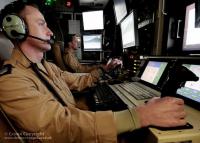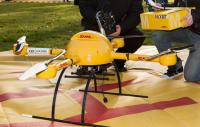-
User-centric control software improves drone pilot performance, safety

A new study into the safety of drone control interfaces suggests that an overhaul of remote control methods ranging from joysticks to smartphone apps could reduce the number of drone accidents. The findings suggest that current user interfaces used in some drones makes it difficult for pilots to perceive hazards and react appropriately.
-
-
Tracking low-flying unmanned aerial systems in cities
Airspace for the flying public today is perpetually congested yet remarkably safe, thanks in no small part to a well-established air traffic control system that tracks, guides, and continuously monitors thousands of flights a day. When it comes to small unmanned aerial systems (UAS) such as commercial quadcopters, however, no such comprehensive tracking system exists. And as off-the-shelf UAS become less expensive, easier to fly, and more adaptable for terrorist or military purposes, U.S. forces will increasingly be challenged by the need to quickly detect and identify such craft — especially in urban areas, where sight lines are limited and many objects may be moving at similar speeds.
-
-
Rules governing targeted killing by U.S. drones need clarifying
Since the beginning of the conflicts in Iraq and Afghanistan, the United States has dramatically increased use of unmanned drones, developing technology to target and kill those identified as being terrorist leaders. Current U.S. policies on using drones for targeted killing are characterized by ambiguities in interpretations of international law and too many generalities, despite recent efforts by the Obama administration to clarify the policies, a new report finds.
-
-
Technical problems rather than operator errors cause most drone accidents
Research has found that technical problems rather than operator errors are behind the majority of drone accidents, leading to a call for further safeguards for the industry. One of the researchers said the findings illustrated the need for further airworthiness requirements for Remotely Piloted Aircraft Systems (RPAS), as well as the mandatory reporting of all accidents or incidents. “Understanding what happens to drones, even those that don’t cause damage to people or property, is essential to improve safety,” he said.
-
-
Police seized drones trying to smuggle contraband into London prison
The police have seized two drones carrying drugs and mobile phones as they were making their way toward the all-male Pentonville jail in Islington, north London. Drones were increasingly being used to smuggle items into prisons in England and Wales. Figures showed there were thirty-three incidents involving devices in 2015, compared to two in 2014 and none in 2013.bDrugs, phones, mobile chargers, and USB cards were among the items discovered.
-
-
The political role of drone strikes in U.S. grand strategy

Years of debate on the issue of U.S. drone strikes show that many Americans have reservations. People are concerned that drone strikes devalue non-American lives, dangerously expand executive power, and drive terrorism and anti-Americanism. The concerns Americans have about these kinds of drone attacks – apparently unilateral, apparently violating the norm of state sovereignty, and conducted without a formal justice process — reflect well on a public wondering what the U.S. role in the world should be. But assessing the value of drone strikes requires looking beyond the attacks themselves to first identify and prioritize U.S. interests and threats. Only in that context is it possible to decide whether one supports or opposes drone strikes for what they may gain the United States politically.
-
-
Successful flight test of UAV with mass-actuated controls
For the first time an unmanned aerial vehicle that uses moving weights in its wings, instead of traditional control surfaces or ailerons to turn, was successfully flight-tested. A recently graduated University of Texas at Arlington student used existing UTA research to design, build, and test a UAV that uses mass actuation — weights that move back and forth within the wings to change the center of gravity from side to side — to turn while airborne.
-
-
ISIS using drones with explosives, spy cameras: Pentagon

The Pentagon says that ISIS fighters are have been posing a growing threat to U.S. and Iraqi forces by using small commercial drones to carry improvised explosives devices (IEDs) or surveillance cameras. These drones are especially threatening because they can evade detection. The growing threat led the Joint Improvised-Threat Defeat Agency, the Pentagon’s office charged with keeping tab on and countering IEDs, to ask Congress for permission to reallocate $20 million to provide money for a counter-drone program.
-
-
Hackers could easily cause drones to ignore human controllers, or crash
Sales of drones — small flying machines equipped with cameras — are soaring. But new research by a computer security team has raised concerns about how easily hackers could cause these robotic devices to ignore their human controllers and land or, more drastically, crash. The researchers say that more secure flying devices are needed for aerial deliveries and photography.
-
-
Infrared thermal imaging system spots menacing drones at a distance
With the start of the UEFA Euro 2016 soccer tournament kicking off on10 June, expecting to draw a large international crowd at ten different stadiums in cities across France, security measures have been carefully considered by the organizers in light of a turbulent past couple of years in Europe and abroad. The growing popularity of the use of drones has necessitated consideration of counter-UAV technologies to thwart a terrorist attack using this method.
-
-
France to employ anti-drone technology to protect Euro 2016 soccer games
France will employ anti-drone technology to interfere with and take control of any flying machines breaching strict no-fly zones over stadiums where the games of the 2016 European Soccer Championship will be played. The technology is part of broad and unprecedented security measures taken to secure Europe’s biggest sports event. French security agencies have been training for some time for the possibility of drones used to disperse chemical agents over crowds.
-
-
FAA expands initiative to detect unauthorized drones near airports
The Federal Aviation Administration (FAA) is expanding the part of its Pathfinder Program that focuses on detecting and identifying unmanned aircraft systems (UAS) flying too close to airports. The FAA says that the other day the agency signed Cooperative Research and Development Agreements (CRDAs) with Gryphon Sensors, Liteye Systems Inc., and Sensofusion. The FAA will evaluate procedures and technologies designed to identify unauthorized UAS operations in and around airports.
-
-
Miniaturized fuel cell makes drones fly more than one hour
Drones are used for various applications such as aero picturing, disaster recovery, and delivering. Despite attracting attention as a new growth area, the biggest problem of drones is its small battery capacity and limited flight time of less than an hour. A newly developed fuel cell can solve this problem.
-
-
Fast, lightweight autonomous air vehicle completes first flight data tests
DARPA’s Fast Lightweight Autonomy (FLA) technologies could be useful in addressing a pressing surveillance shortfall. Military teams patrolling dangerous overseas urban environments, and rescue teams responding to disasters such as earthquakes or floods, currently can use remotely piloted unmanned aerial vehicles (UAVs) to provide a bird’s-eye view of the situation, but to know what is going on inside an unstable building or a threatening indoor space often requires physical entry, which can put troops or civilian response teams in danger.
-
-
Autonomous cloud seeding aircraft successfully tested in Nevada
A team of Nevada scientists and unmanned aircraft systems (UAS) engineers have successfully flight-tested the first-ever autonomous cloud seeding aircraft platform. Cloud seeding flare tests were deployed from Drone America’s DAx8 UAS aircraft flown in Reno in late January.
-
- All
- Regional
- Water
- Biometrics
- Borders/Immig
- Business
- Cybersecurity
- Detection
- Disasters
- Government
- Infrastructure
- International
- Public health
- Public Safety
- Communication interoperabillity
- Emergency services
- Emergency medical services
- Fire
- First response
- IEDs
- Law Enforcement
- Law Enforcement Technology
- Military technology
- Nonlethal weapons
- Nuclear weapons
- Personal protection equipment
- Police
- Notification /alert systems
- Situational awareness
- Weapons systems
- Sci-Tech
- Sector Reports
- Surveillance
- Transportation
Advertising & Marketing: advertise@newswirepubs.com
Editorial: editor@newswirepubs.com
General: info@newswirepubs.com
2010-2011 © News Wire Publications, LLC News Wire Publications, LLC
220 Old Country Road | Suite 200 | Mineola | New York | 11501
Permissions and Policies
Editorial: editor@newswirepubs.com
General: info@newswirepubs.com
2010-2011 © News Wire Publications, LLC News Wire Publications, LLC
220 Old Country Road | Suite 200 | Mineola | New York | 11501
Permissions and Policies
